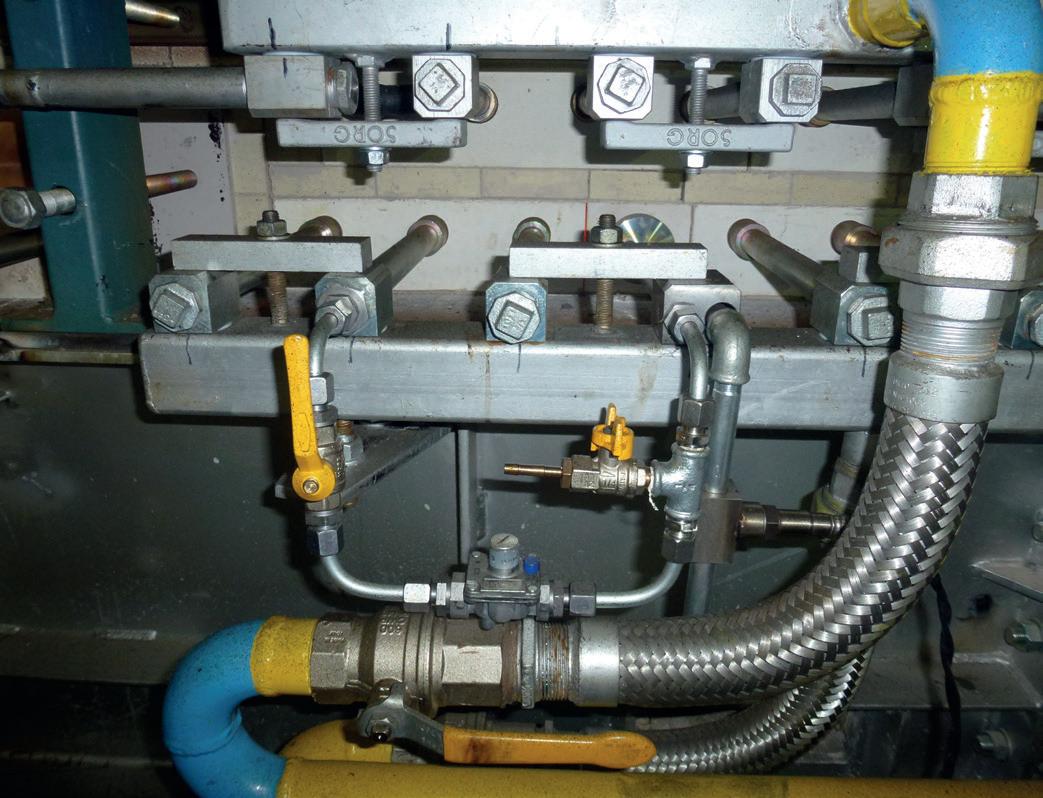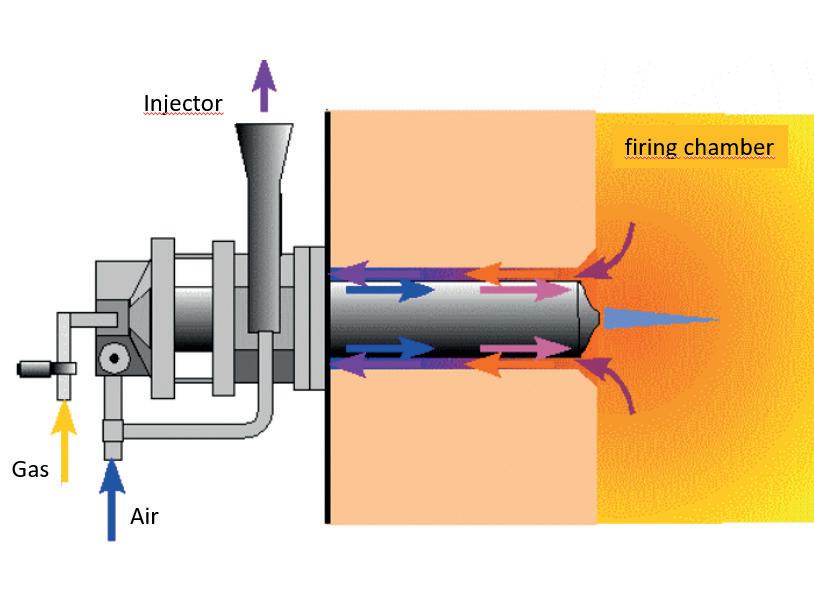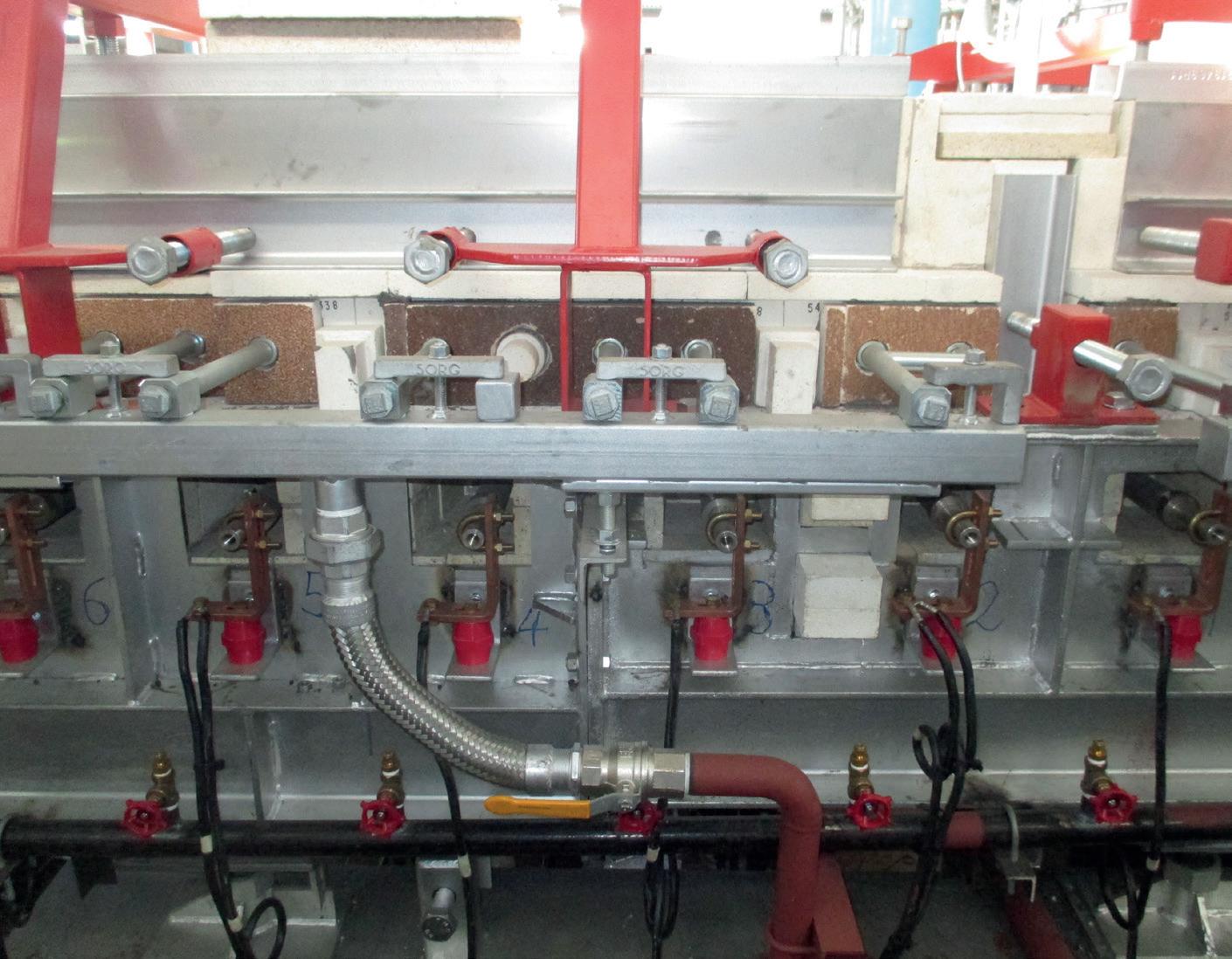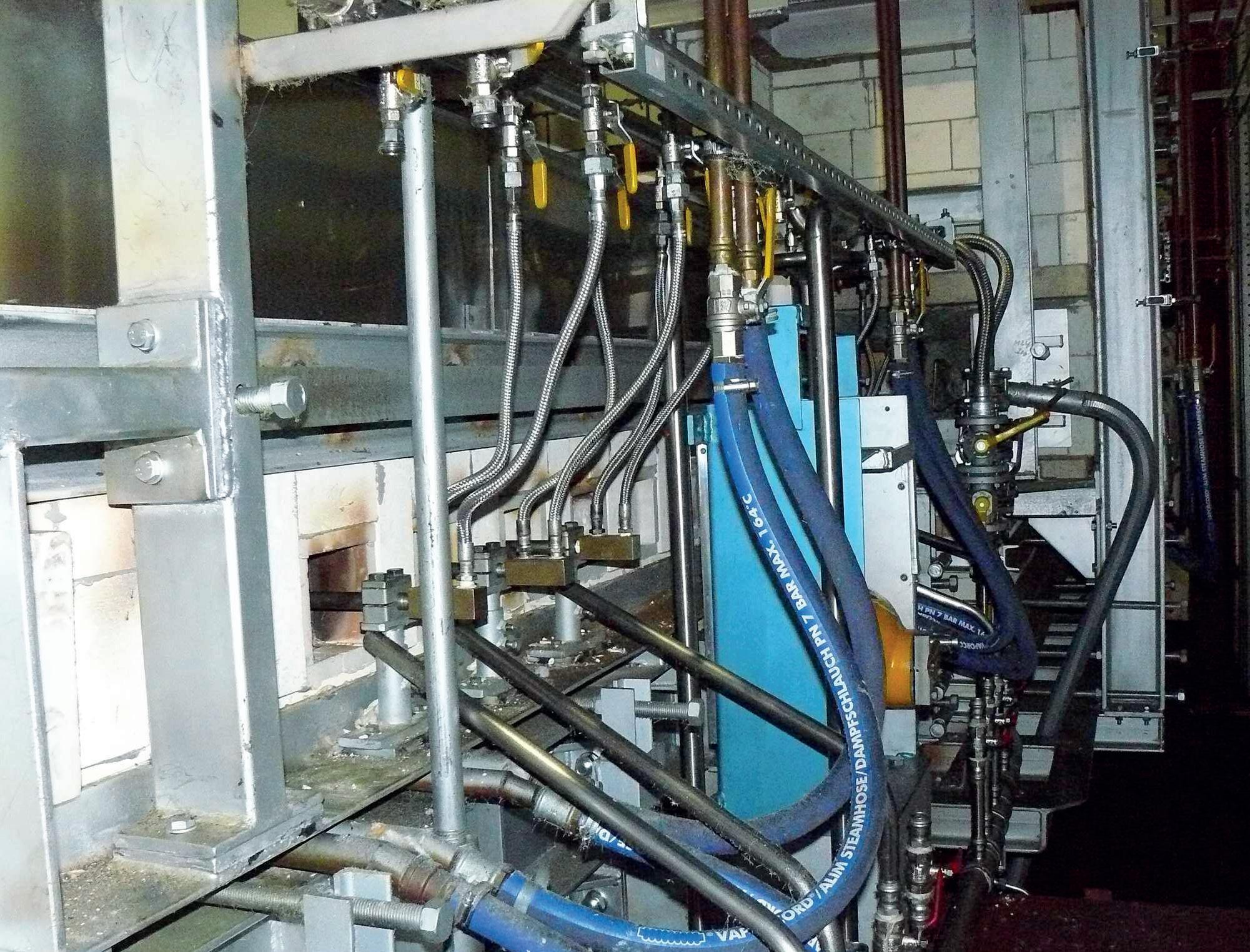
11 minute read
Glass conditioning: Sorg
� Fig 2. Sorg OMT unit mounted on forehearth � Fig 3. Recuperator burner. Source: Schunk Ingenieurkeramik GmbH, Willich, Andre‘ Hiemann

An often-underestimated factor is the optimal heating and cooling setting of the different forehearth zones. In many glass factories, there are no longer any specialists for working end or forehearth settings. The so-called “feeder man” has been rationalised away. Personnel is in short supply in many places nowadays. Often these jobs have to be done by the furnace or production staff.
But they usually lack the time, the detailed knowledge and the experience for this job. Therefore, it often turns out that in some control zones, cooling and heating are done simultaneously, which of course means unnecessary additional energy consumption.
The forehearth superstructure also leaks, resulting in the entry of false air, which leads to higher energy consumption.
This can lead to faulty air circulation, which disproportionately cools the glass. As the glass must be heated again, this results in additional energy consumption that is not insignificant.
Oxygen
Enriching the combustion air with oxygen saves primary energy through improved heat transfer with a simultaneous increase in the combustion chamber temperature by means of higher flame temperatures.
However, enrichment has several disadvantages, so this process is only used in exceptional cases. Also, the cost of adapting the normal heating system for oxygen and the cost of oxygen itself are high compared to the benefits.
Oxygenating the combustion air is not harmless because it increases the flame temperature (the burner block material must be suitable for such high temperatures) and the risk of backfire. The safety systems must be adapted for the use of oxygen. An additional control effort is necessary to add oxygen at a constant volumetric rate.
Oxygen-enriched combustion air with more than 25% oxygen content changes the applicable regulations.
The heating system must then be designed in accordance with EN7462:2020 (paragraph 4.5.1) as for a pure oxygen system.
These points make oxygen enrichment usually no longer economically viable.
Reduction of energy consumption in new installations
As is usual in the furnace area, preheating the combustion air only makes sense if the air can be preheated above 700°C. Using the usual burner manifold heating in the forehearth zone is impossible (ignition limits natural gas). Preheating well below this temperature or slightly preheating with exhaust gases to a combustion air temperature of 60°C would theoretically only contribute to a small saving of 1%.
On the other hand, preheating is also very expensive to carry out, as the stations and all piping - as in a house heating system, for example - must be insulated. Amortisation of these additional expenses seems more than questionable.
The hot forehearth exhaust gases have often been discussed as a savings potential but are hardly feasible in practice.
Since the exhaust gases of the various heating zones on the forehearth or working end come out of many individual openings – in contrast to the furnace exhaust gas – the respective amounts of energy are too low for reuse. The many exhaust gas outlets would have to be combined in a pipe system to collect all exhaust gases, which cannot be implemented sensibly. The result would be pressure and control problems in the forehearth. Furthermore, there are problems with maintenance due to complexity and inaccessibility.
A complete enclosure of a forehearth is theoretically conceivable to collect exhaust gas.
However, this is hardly possible in practice, as many components on the forehearth (thermocouples, stirrers, etc.) would not withstand the temperature load in the enclosure and would have to be adapted.
Also, an impact on the various exhaust gas openings would pose a risk to the heating and cooling systems. A forehearth is expected to maintain a temperature constancy of +/- 1° at the most, so any intervention on the pressure conditions would be counterproductive. Likewise, the operation, maintenance and control of the installation or parts thereof are impossible or only possible with difficulty.
So far, Sorg is unaware of any benefit from using forehearth exhaust gases, except in the E-glass industry. The collection of waste gases from many individual zones has only taken place in some forehearths for E-glass.
Recuperator burners or other burner systems
As early as 1987, Sorg pioneered the field of glass conditioning in the working end area. The same heating and cooling systems used in the latest forehearths at that time have also been used in working
ends since then. Thus, the working end became a component of glass conditioning for the first time.
Before that, several large single burners were normal for heating; there were no cooling systems on the working ends; and the working end was basically a glass distributor, which belongs to the melting end. In most systems today, using the working end as preconditioning is mandatory.
However, at some installations it would be possible to reduce the number of burners and use the process heat of the waste gases with recuperative burners.
These burners work according to the heat exchanger principle. Part of the waste gas heat is transferred to the combustion air (Fig 3).
Preheating can save fuel. How much depends on the achievable combustion air temperature and the ratio of combustion air temperature to process temperature.
For some working ends, as mentioned above, it would certainly be possible to work with only a few single burners instead of burner manifolds, provided there is enough time for conditioning and homogenisation in the forehearth area. However, this would not result in significant energy savings, as there is usually little need for heating on working ends.
Electricity as a heating medium
glass. Gas heating, as well as forehearths with electric heating elements above the glass bath, have to transfer the energy into the glass via heat radiation above the glass bath surface. Therefore, forehearths heated with these heating elements also save energy, but not to the same extent as directly heated forehearths. Molybdenum electrodes are used in working ends and forehearths for amber and green glass. The use of soda-lime flint glass can sometimes be problematic, as reactions between the electrode material and glass can lead to seeds formation and dark streaks (molybdenum abrasion) in the glass. An alternative electrode material to molybdenum is tin oxide. Platinum electrodes are not an alternative for soda-lime glasses due to cost reasons. In the case of high-quality flint glass, forehearths heated with heating elements are preferred as there is no foreign material (electrodes) in contact with the glass. The advantages of electric heating are not only energy savings and no exhaust gases but also better thermal homogeneity. The disadvantages are, on the one hand, the considerably higher investment costs and, on the other hand, the expensive electricity prices at many locations in the world. These prices cause higher energy costs despite the energy savings. But the energy savings, the reduction in emissions, and thus the savings in taxes on emissions will soon make electric heating profitable. A Electrically heated forehearths are compelling reason for installing electric constructed either as directly heated forehearths with electrodes immersed in the glass or with electrical radiation elements (heating elements) above the glass bath.
A special situation arises in the spout area. Due to the confined space within the rotating tube in the spout, gas heating is the best and most practical solution for this area. Only if gas (or oil) is not available the spout should be heated electrically with heating elements.
Sorg has been supplying electrically heated forehearths since the 1970s, the first for tableware glass with heating elements above the glass bath. The first applications for electrodes were in C-glass and soda-lime glass. In the meantime, opal glass, borosilicate glass forehearths and working ends are also heated allelectrically with electrodes.
All-electric forehearths with immersed electrodes have been proven to save between 60% and 70% of energy as the power is transferred directly into the � Fig. 4 Hybrid-heated forehearth. heating by electrode is the enhanced performance and productivity obtained through better thermal homogeneity.
The installation of additional electrical heating in gas-heated forehearths (hybrid heated forehearth) is paramount. This usually serves to improve thermal homogeneity (Fig 4).
Use of oxygen
Sorg equips working ends and forehearths with oxygen heating. For this, important experience and knowledge were gained, besides practical experiences at a test stand in the Sorg technical centre. Oxygen burners of various designs were evaluated.
A heating system with oxygen and natural gas is completely different from the known systems with air and natural gas or LPG. All the necessary components such as stations, piping and burners on the forehearth must be designed entirely differently. For reconstructions or new systems, the entire equipment must be completely replaced or equipped accordingly.
Increasing the oxygen content from the usual 20.9% in the air to almost pure oxygen increases the flame temperature from approx. 1900° to approx. 2700°C. This must be considered in connection with the refractory lining of the combustion chamber, especially the burner blocks. Due to the higher flame temperature, this heating of the forehearth is especially
Continued>>


� Fig 5. Forehearth heated with oxygen/LPG.
suitable for glasses such as borosilicate or basalt, as very high combustion chamber temperatures are required (Fig 5). This is not necessary for classic soda-lime glasses, for example.
Many operating data show that, with the use of oxygen and gas as a heating medium, compared to firing with air and gas, the energy consumption is reduced by approx. 50% to 60%.
Despite all the advantages, for normal soda-lime glass the cost of the investment and currently the cost of the oxygen fuel are still too high. A quick amortisation is not achievable.
Use of hydrogen as a heating medium
For many thermoprocessing installations, conversion to electric heating is not possible, or not completely possible, if it makes any technical sense at all. That is why hydrogen is a much-discussed “bearer of hope” for the future, for the avoidance of greenhouse gases – in case green hydrogen is available. The combustion of hydrogen only produces water vapour, not CO2. That is why many studies and projects are currently investigating the limits of this conversion from natural gas to hydrogen or the maximum enrichment of hydrogen in natural gas regarding pipeline networks, gas storage facilities and industrial burners.
However, the influence of hydrogen combustion on the melt and the glass is also being investigated.
In part, the existing gas supply infrastructure can be used to transport and store hydrogen. Before the conversion to natural gas, many gas grids used to be operated with so-called town gas, which consisted of up to 51% hydrogen.
The existing German natural gas network has so far been approved for the admixture of 10% hydrogen.
However, the new target is to allow up to 20%, and initial trials are underway.
Unfortunately, you cannot simply replace natural gas with hydrogen as a heating medium. Hydrogen has a different combustion behaviour. The flame speed is about eight times faster, and the ignition ranges much larger. The flame becomes more compact and hotter when hydrogen is added.
Backfiring prevention measures are important in installation parts, such as burner manifolds, pipe systems, etc. It is also essential that the air/gas mixture is perfect, but this is no problem for the Sorg VMC heating system. Extensive tests by the manufacturers have shown that the gas devices used up to now are functional even with a very high hydrogen content in the mixture.
Hydrogen can be produced in different ways. There are now different colours for labelling them. ‘Green’ hydrogen through electrolysis - from renewable energies - using green electricity naturally has the most significant advantages from an ecological and economic point of view.
We are at the beginning of a new era for the glass industry. Electricity cannot be used for all glass.
Therefore, it must be carefully examined what is necessary to replace natural gas or enrich it with hydrogen.
Summary
New insulating forehearths, better than the current standard ones, are rarely useful, if possible at all. Nowadays, great tonnage flexibility is required for the forehearth. This is only feasible if the heating and cooling systems are coordinated with the insulation.
Historically, there have been approaches to recover energy from the exhaust gases at the working end of a forehearth. These approaches are only possible to a limited extent because often the technology for this is not yet mature or efficient enough.
Or because, for example, the conversion of residual energy, e.g., for water heating is not a solution. In the middle of a glass factory, where there are often working ends and forehearths, nobody needs hot water! Moreover, if you have to transport this amount of energy 20 metres, it does not make sense from an energy point of view. The effort is disproportionate to the energy savings.
The most efficient method of reducing energy consumption is direct electrical heating with immersed electrodes. However, energy savings do not equal energy cost savings, especially for electrically heated systems.
Electricity costs much more than natural gas in most countries.
Environmental discussions may change this. Investment and maintenance costs must also be considered in addition to ensuring that this type of heating is suitable for the application.
The future of forehearth heating could be a mixture of electric and gas heating. Oxygen could play a more substantial role in reducing energy consumption and exhaust gases.
Replacing natural gas with hydrogen seems to be one of the most promising possibilities at the moment. However, we are only just beginning to gain experience of what the use of hydrogen can mean for the glass industry.
What makes the most sense is often also determined by the location of the installation. �
*Sorg Glass Conditioning, Lohr am Main, Germany www.sorg.de

GLASS MACHINERY











